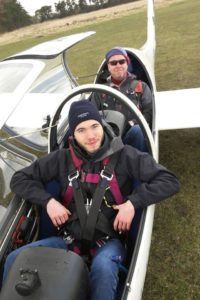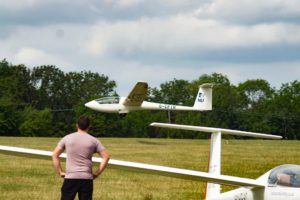From day one you will begin your journey of becoming a solo pilot, which may seem very daunting at first. This page explains what you can expect from your training and offers some advice for making the most of your time on the airfield.
Training Syllabus
All of your training will follow the strict syllabus that the British Gliding Association (BGA) dictates. The course teaches you everything from the basic effects of controls, how to handle abnormal situations and how to launch and land the gliders. You will more than likely be taught be several different instructors while you learn, which gives you the opportunity to experience different teaching styles and different ways of explaining the art of flying.
As a pre-solo pilot you will receive a training card and a logbook. The logbook will help you to keep track of the amount of flying you have done and there is space for you to note down your own comments for each flight. The training card allows you and your instructors to ensure that all aspects of flying are taught sufficiently and successfully. You will present this card to your instructor every time you fly, so that the instructor has an understanding of the stage of training you are at. Your training and the rate at which you progress is personal to you, there is no pressure to rush your training.
Your Pre-Solo Training

The aim of your pre-solo training is twofold. First of all, the aim is for you to understand how the glider and its controls work so that you are able to control the glider during all stages of the flight, and also to avoid and deal with any unusual situations that you could find yourself in.
Secondly, the instructors aim to teach you how to fly safely. This means that you should be able to avoid any situations, which could potentially be dangerous, as well as teaching you how to recover from these. You will learn about and practice things like stalls, spins, spiral dives and launch failures. If you are making good progress and the weather is on your side, you should be able to go solo after 40 to 80 flights. But this is just an estimate – some students are able to do it in less time and some need more time. However, there is still much more to learn beyond going solo…
Beyond Solo

It’s easy for you to get fixated on going solo, of course it is a hugely rewarding experience to fly an aircraft by yourself. However, you should not let yourself stagnate, there is so much more to gliding than flying a few circuits by yourself! Here are a few things you should be considering once you get to solo:
- Bronze Endorsement – The bronze endorsement is a theoretical and practical exam which you can take once you’re solo. It demonstrates that you’re a safe and responsible pilot and is a requirement for any of these further endorsements.
- Cross Country Endorsement – Further training including navigation and field selection. This opens the door for you to be able to fly further from the airfield and even land somewhere else.
- Silver Badge – An internationally recognised award that demonstrates you’re an experienced and skilled pilot. The badge has several parts to it (which can be completed anytime after going solo), including; a 5 hour duration flight, a 50km cross-country flight, a 1000 metre height gain.
- Aerobatic Badge – Learn how to perform aerobatic maneuvers, such as loops, humpty bumps and wingovers.
- Basic Instructor – If you’re experienced enough, you may wish to give back to the gliding community by providing instruction to new students. There are several grades of instructor, the lowest level being the ‘basic instructor’ or ‘BI’ who teach the first few lessons of the syllabus.